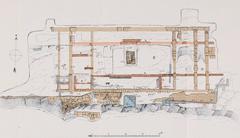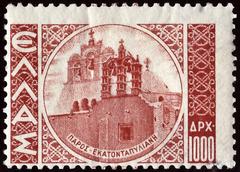Visiting the Archaeological Museum of Paros: Hours, Tickets, and Travel Tips
Date: 20/07/2024
Introduction
The Archaeological Museum of Paros, located in Parikia, the capital of Paros, Greece, serves as a vital repository of the island’s extensive historical and cultural legacy. Established in 1960, this museum was designed to house and preserve the numerous archaeological finds from the island, ranging from the Neolithic period to the early Christian era. The island of Paros, renowned for its high-quality marble, has been a significant center of trade and culture since antiquity. This rich historical backdrop is vividly brought to life through the museum’s diverse collections and exhibits. Among the museum’s most notable items are the Gorgon of Paros, the Nike of Paros, and the Parian Chronicle, each offering unique insights into the island’s past (Greece-is, Ancient Greece). The museum itself is an architectural marvel, harmonizing modern design with traditional Cycladic elements, and serves as a center for not only preservation but also education and cultural activities. Guided tours, educational programs, and temporary exhibitions further enhance the visitor experience, making the Archaeological Museum of Paros a must-visit for history enthusiasts and casual travelers alike (Parosweb, Greek Travel Pages).
Table of Contents
- [Establishment and Early History](#establishment-and-early-historyestablishment-and-early-history)
- [Collections and Exhibits](#collections-and-exhibitscollections-and-exhibits)
- [Historical Significance](#historical-significancehistorical-significance)
- [Architectural Features](#architectural-featuresarchitectural-features)
- [Conservation and Research](#conservation-and-researchconservation-and-research)
- [Educational and Cultural Programs](#educational-and-cultural-programseducational-and-cultural-programs)
- [Visitor Information](#visitor-informationvisitor-information)
- [Travel Tips and Nearby Attractions](#travel-tips-and-nearby-attractionstravel-tips-and-nearby-attractions)
- [FAQ](#faqfaq)
- [Conclusion](#conclusionconclusion)
- [References](#referencesreferences)
Establishment and Early History
The Archaeological Museum of Paros, located in Parikia, the capital of Paros, Greece, was established in 1960. The museum was created to house the numerous archaeological finds from the island, which date from the Neolithic period to the early Christian era. The establishment of the museum was a significant step in preserving the rich cultural heritage of Paros, an island known for its historical importance in the Cyclades.
Collections and Exhibits
The museum’s collections are extensive and diverse, showcasing artifacts from various periods of Parian history. One of the most notable exhibits is the Gorgon of Paros, a marble relief from the 6th century BCE, which depicts the mythical Gorgon Medusa. This artifact is a prime example of early Greek sculpture and provides insight into the artistic styles and religious beliefs of the time.
Another significant exhibit is the Nike of Paros, a marble statue from the 5th century BCE. This statue represents the goddess Nike, symbolizing victory, and is a testament to the island’s artistic achievements during the Classical period. The museum also houses a collection of Cycladic figurines, which are among the earliest examples of Greek art, dating back to the 3rd millennium BCE.
Historical Significance
Paros has been inhabited since the Neolithic period, and its strategic location in the Aegean Sea made it an important center of trade and culture throughout antiquity. The island was known for its high-quality marble, which was used in some of the most famous sculptures of ancient Greece, including the Venus de Milo and the Parthenon Marbles.
The artifacts housed in the Archaeological Museum of Paros provide valuable insights into the island’s historical significance. For example, the Parian Chronicle, a marble stele inscribed with a chronological list of events from Greek history, is one of the most important historical documents from ancient Greece. This artifact, dating from the 3rd century BCE, offers a unique perspective on the historical events that shaped the ancient world.
Architectural Features
The museum building itself is an example of modern Greek architecture, designed to blend harmoniously with the traditional Cycladic style of Parikia. The structure is characterized by its whitewashed walls and simple, geometric lines, which are typical of the Cycladic architectural tradition. The museum’s design allows for natural light to illuminate the exhibits, creating a serene and contemplative atmosphere for visitors.
Conservation and Research
The Archaeological Museum of Paros plays a crucial role in the conservation and study of the island’s archaeological heritage. The museum’s staff includes archaeologists, conservators, and researchers who work tirelessly to preserve and study the artifacts in their care. The museum also collaborates with international institutions and universities to conduct research and excavations on the island.
One of the most significant conservation projects undertaken by the museum is the restoration of the Sanctuary of Apollo, located on the nearby island of Despotiko. This sanctuary, which dates back to the Archaic period, is one of the most important archaeological sites in the Cyclades. The museum’s efforts to preserve and study this site have provided valuable insights into the religious practices and architectural styles of ancient Greece.
Educational and Cultural Programs
The Archaeological Museum of Paros is not only a repository of ancient artifacts but also a center for education and cultural activities. The museum offers a range of educational programs for school groups, including guided tours and hands-on workshops. These programs are designed to engage students with the island’s rich history and inspire a new generation of archaeologists and historians.
In addition to its educational programs, the museum hosts temporary exhibitions, lectures, and cultural events throughout the year. These events provide opportunities for visitors to learn more about the island’s history and culture and to engage with the local community.
Visitor Information
The Archaeological Museum of Paros is open to visitors year-round, with extended hours during the summer months. The museum is easily accessible from the port of Parikia, and there are several nearby attractions, including the Church of Panagia Ekatontapiliani, one of the oldest and most important Christian monuments in Greece.
Visiting Hours
- Summer (April 1 - October 31): Monday to Sunday, 8:30 AM - 3:30 PM
- Winter (November 1 - March 31): Tuesday to Sunday, 8:30 AM - 3:30 PM
Ticket Prices
- General Admission: €6
- Reduced Admission: €3 (students, seniors, etc.)
- Free Admission: Children under 18, EU students, etc.
Visitors to the museum can explore the exhibits at their own pace or join a guided tour for a more in-depth experience. The museum also offers audio guides in multiple languages, providing detailed information about the artifacts on display. For more information about visiting the Archaeological Museum of Paros, including opening hours and ticket prices, please visit the official website.
Travel Tips and Nearby Attractions
When visiting the Archaeological Museum of Paros, consider exploring the nearby historical sites in Parikia. The Church of Panagia Ekatontapiliani, also known as the Church of a Hundred Doors, is a must-visit. Another notable site is the Frankish Castle, offering panoramic views of Parikia and the surrounding area.
FAQ
What are the visiting hours for the Archaeological Museum of Paros?
- The museum is open year-round with extended hours during the summer months. Summer hours are from 8:30 AM to 3:30 PM, Monday to Sunday. Winter hours are from 8:30 AM to 3:30 PM, Tuesday to Sunday.
How much are tickets to the Archaeological Museum of Paros?
- General admission is €6, reduced admission is €3, and free admission is available for children under 18, EU students, and others.
Are there guided tours available at the Archaeological Museum of Paros?
- Yes, guided tours are available for a more in-depth experience. Audio guides in multiple languages are also offered.
Conclusion
The Archaeological Museum of Paros is a treasure trove of ancient artifacts that offers a fascinating glimpse into the island’s rich history and cultural heritage. From its extensive collections and exhibits to its educational programs and conservation efforts, the museum plays a vital role in preserving and promoting the archaeological heritage of Paros. Whether you are a history enthusiast or a casual visitor, the museum provides a memorable and enriching experience that is not to be missed.
For more updates and information, download the Audiala app, check out related posts on our website, or follow us on social media.
References
- Visiting the Archaeological Museum of Paros - History, Tickets, and Tips, 2023, Greece-is
- Discover Key Exhibits and Collections at the Archaeological Museum of Paros - A Visitor’s Guide, 2023, Ancient Greece
- Visiting the Archaeological Museum of Paros - Hours, Tickets, and Tips, 2023, Parosweb
- Discover Key Exhibits and Collections at the Archaeological Museum of Paros - A Visitor’s Guide, 2023, Greek Travel Pages
- Visiting the Archaeological Museum of Paros - Hours, Tickets, and Tips, 2023, Hellenic Ministry of Culture and Sports
- Discover Key Exhibits and Collections at the Archaeological Museum of Paros - A Visitor’s Guide, 2023, Epigraphic Museum

